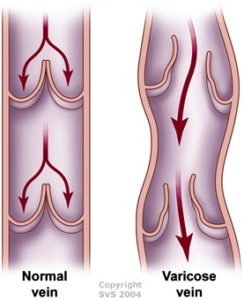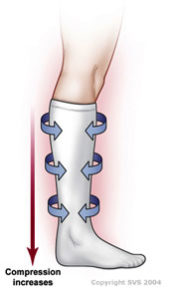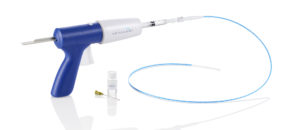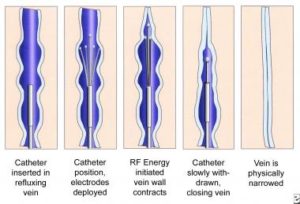What are varicose veins?
 Among other things, veins are responsible for bringing blood back to the heart, working against gravity when you are standing. When you walk, muscles in your leg squeeze the veins and help blood flow back into the heart. In normal veins, a series of valves assist this process.
Among other things, veins are responsible for bringing blood back to the heart, working against gravity when you are standing. When you walk, muscles in your leg squeeze the veins and help blood flow back into the heart. In normal veins, a series of valves assist this process.
Varicose veins are large bulging veins in the legs that can cause many different symptoms. With varicose veins and a related condition called chronic venous insufficiency, poorly functioning valves allow the blood to pool in the lower leg. Varicose veins can occur in almost anyone and affect up to 35% of people in the United States.
What causes varicose veins?
You may inherit a tendency to develop varicose veins from a parent. However, they can be caused by multiple other risk factors including female gender, multiple pregnancies, history of DVT (deep vein thrombosis), obesity and lifestyle.
What are the symptoms of varicose veins and chronic venous insufficiency?
Pain, itching, swelling, burning, leg heaviness and tiredness, skin discoloration are all symptoms of varicose veins and chronic venous insufficiency. You may also experience no symptoms other than bulging veins. The symptoms typically worsen throughout the day and are relieved by leg elevation or wearing compression socks.
Sometimes, varicose veins clot and become painful, hot, hard and discolored. This is called phlebitis and is an uncomfortable but temporary condition. Clots associated with phlebitis are limited to superficial veins and are not dangerous like the blood clots in the deep veins which can travel to the heart or lung and require prompt treatment. Varicose veins can also burst and bleed. Holding pressure and elevating the leg will help stop the bleeding. Spontaneous bleeding, skin tears and ulceration are signs of severe chronic venous insufficiency and require prompt medical attention.
How are varicose veins treated?
During your initial visit with us, an ultrasound to evaluate your veins and the valves within the veins will be performed. This will guide the treatment options recommended by Dr. Yeaney.
Compression socks
 Compression socks, usually 20-30 mmHg or stronger, can help relieve the symptoms you are experiencing. If you have insurance, most companies require that you wear compression socks for at least three months before covering any other type of treatment for varicose veins and chronic venous insufficiency. If compression socks provide insufficiency relief, radiofrequency ablation may be an option.
Compression socks, usually 20-30 mmHg or stronger, can help relieve the symptoms you are experiencing. If you have insurance, most companies require that you wear compression socks for at least three months before covering any other type of treatment for varicose veins and chronic venous insufficiency. If compression socks provide insufficiency relief, radiofrequency ablation may be an option.
VenaSeal™
 The VenaSeal™ closure system is the only non-tumescent, non-thermal, non-sclerosant procedure that uses a proprietary medical adhesive delivered endovenously to close the vein. This unique approach eliminates the risk of nerve injury when treating the small saphenous vein, which is a risk sometimes associated with certain thermal-based procedures. Clinical studies have demonstrated that the procedure is safe and effective. The procedure is administered without the use of tumescent anesthesia, avoiding patient discomfort associated with multiple needle sticks.
The VenaSeal™ closure system is the only non-tumescent, non-thermal, non-sclerosant procedure that uses a proprietary medical adhesive delivered endovenously to close the vein. This unique approach eliminates the risk of nerve injury when treating the small saphenous vein, which is a risk sometimes associated with certain thermal-based procedures. Clinical studies have demonstrated that the procedure is safe and effective. The procedure is administered without the use of tumescent anesthesia, avoiding patient discomfort associated with multiple needle sticks.
Radiofrequency ablation
 This state of the art, incision-less procedure is performed in our office. This treatment utilizes a small catheter positioned within the diseased vein through a small needle under ultrasound guidance. The catheter delivers heat to the vein wall, causing it to shrink and the vein to seal closed. Once the diseased vein is closed, blood will reroute itself to other healthy veins. Following the procedure, your leg is wrapped with a compression bandage. You are encouraged to walk and to refrain from prolonged standing and strenuous activity for a short period of time. The average patient typically resumes normal activities within a few days.
This state of the art, incision-less procedure is performed in our office. This treatment utilizes a small catheter positioned within the diseased vein through a small needle under ultrasound guidance. The catheter delivers heat to the vein wall, causing it to shrink and the vein to seal closed. Once the diseased vein is closed, blood will reroute itself to other healthy veins. Following the procedure, your leg is wrapped with a compression bandage. You are encouraged to walk and to refrain from prolonged standing and strenuous activity for a short period of time. The average patient typically resumes normal activities within a few days.
Sclerotherapy
Small, tortuous varicosities typically cannot be treated with radiofrequency ablation. Sclerotherapy may be recommended to address these veins. With the guidance of ultrasound, a small needle is advanced into the diseased vein and sclerosant, a chemical that causes the vein to spasm and clot, is injected. This type of clot is not dangerous and is broken down by your bodys natural processes so that the varicose vein disappears. Small “spider” veins can be treated in the same way, using a very small needle.
Post- treatment
After treatment, we encourage you to continue wearing compression socks during extended periods of standing or sitting and during long distance travel. Continued use of the compression socks will help prevent new varicose vein formation and speed recovery after treatment.

